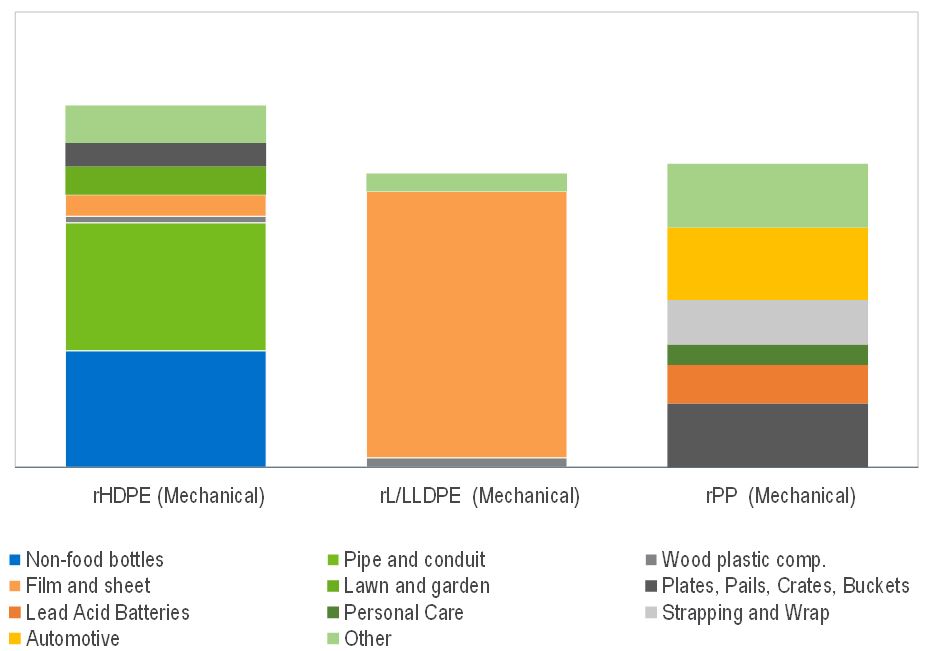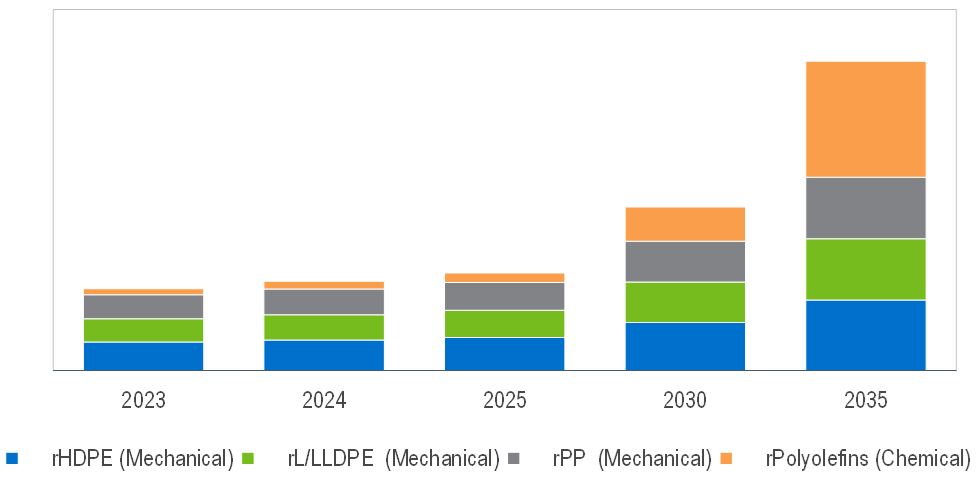Recycled polyolefins and beyond

Bottles remain the leading source of postconsumer recycled HDPE followed by non-bottle rigid, and bags and film. Non-bottle rigids are the fastest growing source for recycled plastics. It includes nondurable goods such as tubs, cups, and similar food containers, also durable items such as pallets, crates, carts, 5-gallon buckets, and electronic housing. Most of the plastic film produced comes from PE resins, either HDPE, LDPE or LLDPE, and most of the reclaimed films are clear films and retail bags. The amounts for mixed colour and agricultural films are modest. Bags and films are the leading source of recycled LDPE and LLDPE. Non-bottle rigids are a minor source. Bottles are negligible. Non-bottle rigid is the primary source of postconsumer PP. Bottles are a modest source, while film is negligible.
The leading applications for rHDPE bottles are non-food bottles (detergent, motor oil, household cleaners etc) and pipes and conduits. The rest consists of wood-plastic composite, film/sheet, garden/lawn products, pallets/crates/buckets, and others (mainly automotive). rLDPE/LLDPE is largely consumed in the production of film and sheet, with wood-plastic composite (lumber/decking) accounting for a small amount. Others include injection moulding, which includes pallets, crates and buckets. rPP is used in lead acid batteries, pails and buckets, personal care, strapping and wrap, automotive and others. Chemical recycling is forecast to grow faster than mechanical recycling. Chemical recycling of polyolefins cannot be accurately compared to mechanical recycling in volume, since most polyolefin recycling includes HDPE, LDPE, LLDPE, PP and PS. There is no breakdown by resin. Chemical recycling is estimated to grow significantly over 2023-35. Europe is forecast to grow the fastest, followed by North America and Asia Pacific, thanks to the more advanced legislative agenda.
The end use markets for recycled polyolefins also differ.
The leading applications for recycled HDPE include non-food bottles (detergent, motor oil, household cleaners etc) and pipes and conduits.
recycled LDPE/LLDPE is largely consumed in the production of film and sheet, with wood-plastic composite (lumber/decking) accounting for a small amount.
Automotive, pails and buckets, strapping and wrap and lead acid batteries are the primary markets for recycled PP.
Recycled Polyolefins and Beyond
It is yet to be determined whether recycled polyolefins obtained through chemical processes are considered as recycled from the regulatory perspective. The obstacle is around energy consumption in thermolysis that is not insignificant. Nevertheless, chemical recycling has been and will continue to grow and play an important role and compliment mechanical recycling.
Global Polyolefins Mechanical and Chemical Recycling
NexantECA - Recycled Polyolefins and Beyond
Find out more...
Market Insights: Recycled Polyolefins - 2023 is one in a series of reports published as part of NexantECA's Markets & Profitability program.
NexantECA’s upcoming Market Insights report provides a comprehensive review of the global recycled polyolefins market, including supply by mechanical method and chemical processses and demand by product and end use.
The following scope is covered:
Discussion regarding key market drivers and constraints for each region
Markets for nine regions: North America, South America, Western Europe, Central Europe, Eastern Europe, Middle East, Africa, Asia Pacific, and China
Competitiveness analysis, including competitive landscape and major recycling facilities (both mechanical and chemical) and cost competitiveness across US, Western Europe and China
Price history and forecast with commentary regarding latest trends
Forecast period: history to 2010 and forecast to 2035
Along with the written report, data is provided in Excel including capacity listings for major recycling facilities.

